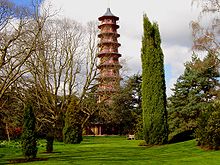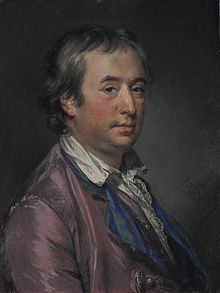William Chambers (architect)
William Chambers RA (born February 23, 1723 in Gothenburg , † March 8, 1796 in London ) was a Scottish architect and founding member of the Royal Academy of Arts . His best-known works include Somerset House in London, the Chinese pagoda in the Royal Botanic Gardens and the golden state carriage used, among other things, for the coronations of British monarchs.
Life


William Chambers was the son of a merchant family. In his childhood, he moved to the Kingdom of Great Britain in Ripon in Yorkshire . In 1740 he joined the Swedish East India Company .
Early work
During several stays in China , he studied the architecture and garden art of the country. On his return he joined the Ecole des Arts in Paris in 1749 as a student of Jacques-François Blondels . He spent another five years in Rome at the Academy of English Professors of the Liberal Arts , studying and copying the ancient and Italian Renaissance . Chambers returned to England in 1755. Even after his return from Italy, he maintained good relationships in France with former friends and former students of the Académie royale de peinture et de sculpture and Prix de Rome laureates of the Académie de France à Rome .
In the years that followed, Chambers ran one of the major London offices alongside Robert Adam . Chambers worked on the design of Kew on behalf of Princess Auguste of Wales (1719–1772) (Princess from 1736 to 1751) . In the years after 1758 Chambers worked with Johann Heinrich Müntz to design the gardens with park and staffage architecture .
Chambers expanded a small hunting lodge built around 1720 in 1760 into an incorporated building of Goodwood House that has survived to this day . He also erected there building the stables, which dates Stables , which is considered one of his most successful designs.
Late work
William Chambers was elected a member of the Royal Academy of Arts in 1768 and was together with Robert Adam Surveyor of the King's Work of George III. From 1761 he was in the unofficial position of Joint Architect to the King , and from 1769 to 1782 he took an official role as Architect to the King ; As the person responsible for the royal buildings, he planned and supervised the maintenance and expansion work of public buildings.
Theories
In his buildings and writings, William Chambers refers to the idea of " Picturesquen ".
Appreciation
William Chambers was one of the first architects of classicism in England , alongside James “Athenian” Stuart and Robert Adam, who was also his greatest rival . His in-depth training at the Ecole des Arts distinguishes his work from the more well-known English gentlemen architects . The differences in the plastic quality of its architecture, the decoration of the interior and its furniture are clearly visible. This makes his work appear heavy and masculine . What Chambers' French-influenced style lacks is playfulness and commodité in comparison with works from Blondel's school, but also in comparison with the work of Robert Adam.
Fonts
- Designs of Chinese buildings, furniture, dresses, machines, and utensils. To which is annexed a description of their temples, houses, gardens, & c. London 1757 ( archive.org ).
-
Desseins des edifices, meubles, habits, machines, et ustenciles des Chinois. Auxquels est ajoutée une descr. de leurs temples, de leurs maisons, de leurs jardins, etc. London 1757.
- Traité des édifices, meubles, habits, machines, et ustensiles des Chinois, gravés sur les originaux dessinés a la Chine, (…) comprised une description de leurs temples, maisons, jardins, etc. Paris 1776 ( archive.org ).
- A treatise on civil architecture in which the principles of that art are laid down and illustrated by a great number of plates accurately designed and elegantly engraved by the best hands. London 1759, doi: 10.3931 / e-rara-13406 .
- Plans, Elevations, Sections and Perspective Views of the Gardens and Buildings at Kew in Surry. London 1763 ( archive.org ).
- A dissertation on oriental gardening. London 1772 ( archive.org ).
Built works (selection)
- Somerset House in London, its most famous building, was built between 1776 and 1796.
- In 1760 the Golden State Coach was built. The rococo carriage was first used in 1762 for the opening of parliament and since 1831 for all the coronations of British monarchs.
- The ten-story pagoda in the Royal Botanic Gardens in 1761 as well as the orangery there and the “Temple of Bellona” and the “Temple of Aeolus”.
- The (former) observatory in Kew for George III.
- Around 1775 a pavilion was built for Henry Scott, 3rd Duke of Buccleuch . Caroline von Braunschweig lived there after separating from the Prince Regent (later King George IV ) from 1799.
- For James Caulfeild, 1st Earl of Charlemont , he designed the Charlemont House (today the location of the Dublin City Gallery The Hugh Lane ) and the Casino Marino (a classical pavilion in the garden of the Marino House ) as well as the chapel and public theater (Examination Hall). of Trinity College .
- He designed Duddingston House in 1760/1761 for James Hamilton, 8th Earl of Abercorn .
- He designed Dundas House, now the seat of the Royal Bank of Scotland , in 1771 for Sir Lawrence Dundas.
- For Joseph Damer, 1st Earl of Dorchester , he designed the neo-Gothic extension of Milton Abbey in Dorset in 1780 , the garden of which was planned by the famous landscape architect Capability Brown .
- In addition, the Dunmore Pineapple in Dunmore Park near Falkirk Chambers is attributed.
- Just like the pagoda in Pagoda Gardens, in Blackheath , a suburb of London.
Duddingston House in Edinburgh
literature
- Howard Colvin: A bibliographical dictionary of British architects. 1600-1840. Yale University Press, New Haven CT et al. a. 1995, ISBN 0-300-06091-2 .
- Thomas Weiss (Ed.): Sir William Chambers and the Anglo-Chinese Garden in Europe. (= Catalogs and publications of the State Palaces and Gardens of Wörlitz, Oranienbaum, Luisium. Volume 2). Hatje Cantz, Ostfildern-Ruit near Stuttgart 1997, ISBN 3-7757-0637-2 .
- Jörg Deuter: Friedrich the Great, the East Asian Compagnie and Sir William Chambers. News about a forgotten application. In: Kevin E. Kandt, Michael Lissok (eds.): Festival from Flora's Cornucopia, Pomonas Gardens and the Helicon. A flower harvest of cultural and art historical contributions to the 65th birthday of Gerd-Helge Vogel. Ludwig, Kiel 2016, ISBN 978-3-86935-281-7 , pp. 47–59.
Web links
- Literature by and about William Chambers in the catalog of the German National Library
- Drawings by Chambers in the Archives of the Sir John Soane Museum
- Traité des édifices, meubles, habits, machines et ustensiles des Chinois , Paris, 1776, e-book from the Vienna University Library ( e-books on demand )
Individual evidence
- ^ A b Sir William Chambers, RA . Royal Academy of Arts
- ^ David Watkin: The Architect King: George III and the Culture of the Enlightenment. Royal Collection Publications, London 2004, ISBN 1-902163-50-8 , p. 15.
- ^ The Observatory and Obelisks, Kew (Old Deer Park) (PDF) Richmond Libraries' Local Studies Collection
| personal data | |
|---|---|
| SURNAME | Chambers, William |
| BRIEF DESCRIPTION | Scottish architect |
| DATE OF BIRTH | February 23, 1723 |
| PLACE OF BIRTH | Gothenburg |
| DATE OF DEATH | March 8, 1796 |
| Place of death | London |





